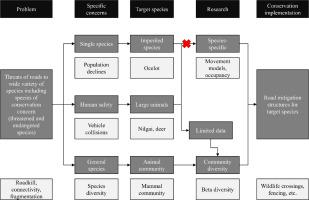交通流量对道路影响区内哺乳动物β多样性的影响
IF 4.4
1区 环境科学与生态学
Q1 BIODIVERSITY CONSERVATION
引用次数: 0
摘要
车辆噪音和人类活动的干扰延伸到附近的栖息地,形成以野生动物群落结构和物种行为变化为特征的道路影响区。这可能会影响道路沿线的保护工作,比如野生动物过境点的建设。为了确保保护工作的有效性,了解哺乳动物如何使用道路区域是很重要的。本研究旨在探讨交通流量和公路距离对公路影响区内哺乳动物β多样性的影响。在2022年5月至2023年4月期间,我们在美国德克萨斯州的一条低流量和高流量高速公路上放置了相机陷阱。我们使用随机块设计放置相机陷阱,横断面垂直于道路。从距离道路50米的地方开始,在7个横断面上每隔200米设置7个相机陷阱。我们评估了交通流量和距离道路的距离对哺乳动物β多样性的影响。我们在研究区发现了几乎所有已知的比啮齿动物大的哺乳动物(24种),包括所有已知的食肉动物(10种)。在高容量道路周围发现的物种较少,这导致了低容量道路和高容量道路之间beta多样性的显著差异。此外,高容量道路周围的社区组成比低容量道路周围的社区组成变化更大。我们的研究揭示了车辆交通对哺乳动物使用道路影响区的影响。交通量是道路周围哺乳动物群落组成的重要指标,道路野生动物缓解结构需要考虑和减轻交通量的潜在影响。本文章由计算机程序翻译,如有差异,请以英文原文为准。

Influence of traffic volume on mammal beta diversity within the road effect zone
Disturbance from vehicle noise and human activity extends into nearby habitat, creating a road effect zone characterized by changes in wildlife community structure and species behavior. This can affect conservation efforts along roads, such as wildlife crossing construction. To ensure that conservation efforts are effective, it is important to understand how mammals use road areas. We aimed to assess how traffic volume and distance to highway influenced mammal beta diversity within the road effect zone. We placed camera traps along a low-traffic and high-traffic highway in Texas, USA, between May 2022 to April 2023. We placed camera traps using a randomized block design with transects set perpendicular to the roadway. Starting 50 m from the road, seven camera traps were set at 200 m intervals in each of seven transects. We assessed how traffic volume and distance from road affected mammal beta diversity. We detected nearly all known mammal species larger than rodents (24 species) in the study area, including all known carnivores (10 species). We detected fewer species around the high-volume road, which contributed to a significant difference in beta diversity between the low and high-volume roads. Additionally, community composition tended to be more variable around the high-volume road than the low-volume road. Our study provides insights into the impacts of vehicle traffic on mammal use of road effect zones. Traffic volume is an important indicator of mammal community composition around roads, and road mitigation structures for wildlife will need to account for and mitigate potential effects of traffic volume.
求助全文
通过发布文献求助,成功后即可免费获取论文全文。
去求助
来源期刊

Biological Conservation
环境科学-环境科学
CiteScore
10.20
自引率
3.40%
发文量
295
审稿时长
61 days
期刊介绍:
Biological Conservation is an international leading journal in the discipline of conservation biology. The journal publishes articles spanning a diverse range of fields that contribute to the biological, sociological, and economic dimensions of conservation and natural resource management. The primary aim of Biological Conservation is the publication of high-quality papers that advance the science and practice of conservation, or which demonstrate the application of conservation principles for natural resource management and policy. Therefore it will be of interest to a broad international readership.
 求助内容:
求助内容: 应助结果提醒方式:
应助结果提醒方式:


